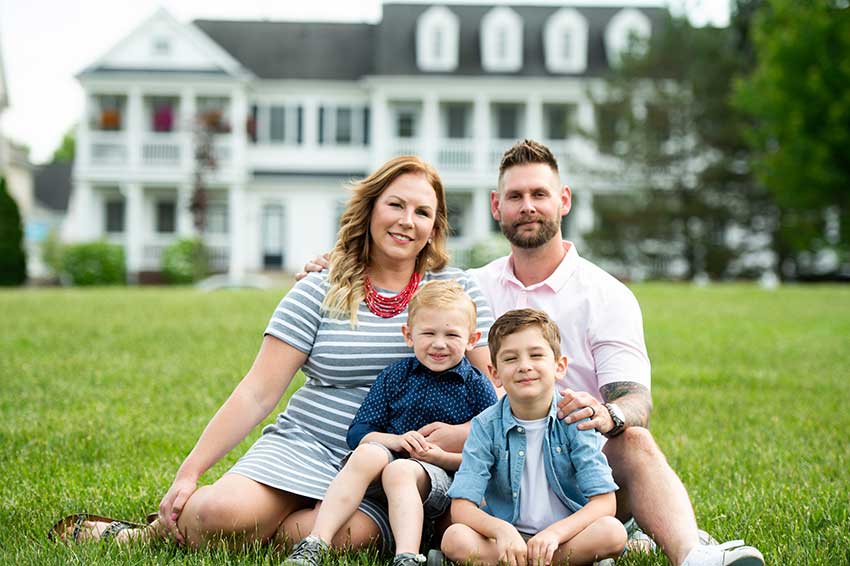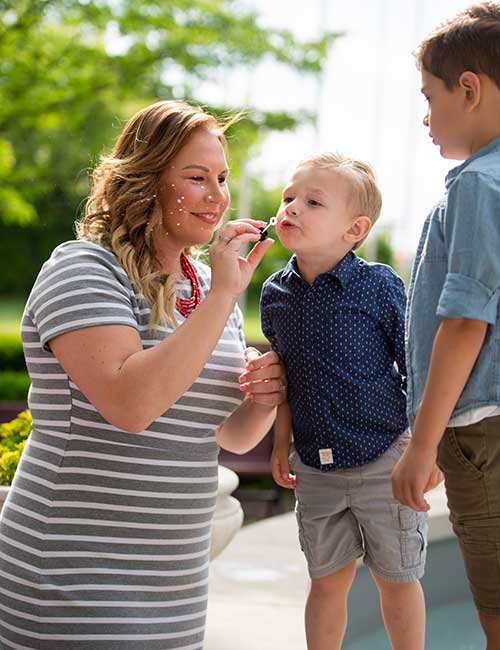Balancing Cancer Treatment with Life
A mom with a plan

from left to right: Logan, Julian, Christian and Brandon
photo credit: Edda Pacifico
Call 734-615-6952 for information on the Families Facing Cancer Program.
Logan Moore had recently stopped nursing her second baby when she noticed a change to her breast. She suspected her body was adjusting after breastfeeding, but her physician offered a mammogram to be sure. Moore agreed, wanting to be able to relax and enjoy her children, Christian, 2, and Julian, 7 months.
She and her husband, Brandon, grew concerned when the mammogram led to a biopsy that day on her breast and lymph nodes. Moore received the official diagnosis two days later. She had stage 3, grade 3 invasive ductal carcinoma.
"I arranged to have my mother-in-law keep our kids overnight. I came home, drank wine and let myself cry. That was my time to lose it," Moore says.
Then it was time to make a plan. Moore, now 36, describes herself as someone who falls into the optimistic hole while doing research. She tries to find the best solution and works to make it happen.
For example, when she was pregnant with Christian, she transitioned from her job at a rental office with Enterprise Rent-A-Car to a more flexible position in the corporate office. She and Brandon lived in a starter home in Canton to save money for their dream home in the community’s Cherry Hill Village.
Facing cancer treatment as a working wife and mother with two small children was no small feat. In addition to making heath care decisions, she and Brandon needed to manage schedules, child care and talking to their kids about her cancer diagnosis.
Staying Informed on Treatment Choices
Moore’s breast cancer was HER2-positive. This meant her cancer had a genetic mutation that made too much of a protein called human epidermal growth factor receptor 2. Her cancer was also ER/PR-negative, indicating it did not depend on estrogen or progesterone to grow.
Moore learned she would receive four chemotherapy treatments of Adriamycin.
In doing internet research, she discovered that the drug is likely to cause hair loss and can cause heart damage in some people. Because of its red color, it has the nickname "the red devil."
Aki Morikawa, M.D., Ph.D., who is now Moore’s oncologist, explains that research can be scary and recommends patients stick to professional websites, such as the Rogel Cancer Center or American Cancer Society.
"Chemotherapy, in general, is scary for patients and they can read horrible things online," she says. "I support web research but recommend patients stick to good websites and resources, not Googling at random. Everyone’s experience is very different."
The Logistics of Treatment, Work and Busy Schedules

Moore’s treatment plan also included 12 doses of the chemotherapy Taxol, surgery and 25 radiation therapy treatments. Wanting her illness to impact her children as little as possible, she closely tracked the days she felt the most well and unwell, using good days to plan activities with her children and husband and bad days to work at home or rest.
She and Brandon arranged to have friends and neighbors over to play with the children during her chemotherapy appointments so she could return home and go right to bed.
"It was important to me not to disrupt my kids’ lives," Moore says. "We had a great social circle and a lot of people wiling to help.”
During her chemotherapy treatments, Moore experienced chest pains that required an X-ray. She learned the devastating news that her cancer was metastatic.
Communicating with Children About Cancer
Moore and Brandon decided not to shy away from using the word cancer with their children. Julian was too young to understand, but Christian was old enough to pick up on worries and sadness, even if he saw it through his young perspective.
"Depending on the child’s developmental level, a child might think the cancer is their fault or that cancer is contagious," says Madison McTevia, a child life specialist at the Rogel Cancer Center. "It is important to talk to them in language they understand and make sure they know who to go to with questions."
Moore convinced Christian she wanted a haircut like baby Julian, which eased the shock of losing her hair. She compared her side effects to the time Christian was sick with the flu. They named her chemotherapy port her “heart button” and explained it was how she took her medicine.
Looking Forward to the Future
Though her metastatic breast cancer requires staying on the targeted therapy Herceptin for the foreseeable future, Moore feels well and experiences minimal side effects. Her most recent scans show no evidence of disease. This means that treatment is working.
"We continue treatment with Herceptin as long as it’s working or as long as the benefit outweighs the risk," Morikawa says. "Logan has done a great job coping with the unknown and continuing with her life."
"I want to keep feeling good until I have a reason not to," Moore says. "Maintaining social groups and regular life is so important. I like to plan things for the future to look forward to."
Call 734-615-6952 for information on the Families Facing Cancer Program.
Continue reading the Fall, 2019 issue of Thrive
Learn more about breast cancer and breast cancer survivorship
